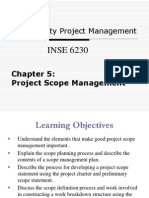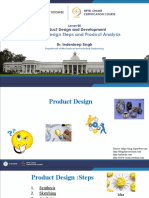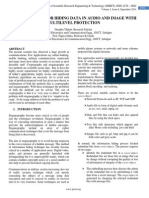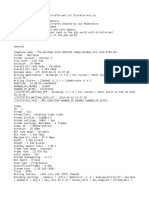Axiomatic Design
Axiomatic Design
Uploaded by
mbuyiselwaCopyright:
Available Formats
Axiomatic Design
Axiomatic Design
Uploaded by
mbuyiselwaOriginal Description:
Copyright
Available Formats
Share this document
Did you find this document useful?
Is this content inappropriate?
Copyright:
Available Formats
Axiomatic Design
Axiomatic Design
Uploaded by
mbuyiselwaCopyright:
Available Formats
AGENDA
INSE 6411 Product Design Theory and Methodology
p Generation Concept Concept Generation Techniques Axiomatic Design
General Facts Framework Methodology Axioms Definition Example
DESIGN CONCEPT GENERATION
AXIOMATIC DESIGN AND ITS USE IN CONCEPT GENERATION
Professor: Dr. Dr Andrea Schiffauerova Presenting: Ana Gabriela Amezaga Flores ID 9431322 February 11th, 2010
Conclusions
DESIGN CONCEPT GENERATION
Mission Statement
Identify customer needs
Establish Target Specifications
Generate Product Concepts
Select a product concept
Refine Specifications
Concept Development
[2] The Mechanical Design Process (3rd ed.) by David G. Ullman
DESIGN CONCEPT GENERATION
DESIGN CONCEPT GENERATION
The purpose of a product, what product must do and how. It involves the flow of energy, material and information and the functions of grasp, position and attach: Energy. Type of energy used on the product: static, electromechanical, mechanical, thermal and so on Material. flow, diverging flow (disassembling Material Can be through flow or separating) or converging flow (assembling or joining) Information. Consist on signals that will ensure the right functioning of the product. product When the products black box is drew all these elements must be included. included
p is an approximate pp p A p product concept description of the technology, working principles, and form of the product. It is a concise description of how the product will satisfy the customer needs. A concept is usually expressed as a sketch[1]
[1] Product Design and Development (4th ed.) by Karl T. Ulrich and Steven D. Eppinger
[2] The Mechanical Design Process (3rd ed.) by David G. Ullman
CONCEPT GENERATION METHODS
FAST REVIEW OF METHODS
6 team members, each member writes down 3 ideas in 5 minutes. After these 5 minutes the sheet will be passed to the right and other 5 minutes will be spent on contributing to these ideas. At the end the best idea is chosen.
Basic Methods
Other Methods
Consist on finding the function that wishes to be designed on an existing product or from the nature for example the trying to imitate sharks skin on the design g of a new scuba diving g suit.
FAST REVIEW OF METHODS
Consists on creating contradictory statements for example: More functions (good), make products larger & heavier (bad) Then this method is followed:
FAST REVIEW OF METHODS
1. Decompose the function
2D l 2.Develop concepts for each function
3. Combine C t Concepts
AXIOMATIC DESIGN
� �
AXIOMATIC DESIGN
� �
p by y Nam Pyo y Suh in MIT Developed Technique applicable to software, organizational, system, material, manufacturing and processes designs Focus on What we want to achieve and ends with i h the h H How to achieve hi i it Purpose: Augment the designers experience and creativity by applying different principles in order to generate robust designs by reducing variability and bias on design concepts
[3] Axiomatic Design by Suh N, Oxford University Press, 2001
[3] Axiomatic Design by Suh N, Oxford University Press, 2001
AXIOMATIC DESIGN
AXIOMATIC DESIGN CONCEPTS
FRs (Functional Requirements)
DPs ( (Design g Parameters)
[3] Axiomatic Design by Suh N, Oxford University Press, 2001
AXIOMATIC DESIGN FRAMEWORK
AXIOMATIC DESIGN FRAMEWORK EXAMPLE
In a semiconductor industry a customer wants:
[3] Axiomatic Design by Suh N, Oxford University Press, 2001
FROM CUSTOMER NEEDS TO FR FRS S
Asking the right questions, to the right customers at the right time: Techniques T h i we can use: QFD (Quality Function Deployment) Pugh Matrix Analytical hierarchy process (AHP) Taguchi loss function
FUNCTIONAL REQUIREMENTS FR FRS S
Define them without thinking on something that has already designed otherwise creativity will be limited. I order In d to generate a robust b design d i you must consider: 1 E 1. Environmental i t l variation i ti 2. Customer usage variation 3 Targeted 3. T d useful f l lif life
WHICH AXIOMS WILL GOVERN THE DESIGN?
AXIOMATIC DESIGN
�
Axiomatic design will consist on mapping the What and the How in order to then apply the required logarithms and theorems.
Remember!! The ultimate goal is to create a robust design without bias or variability and a close to zero level of information
FRs (Functional Requirements)
DPs (Design Parameters)
AXIOMATIC DESIGN EXAMPLE
CONCLUSIONS ABOUT AXIOMATIC DESIGN
�
� �
Axiomatic design is applicable on the designs of: products, processes, systems, software, organizations, materials and businesses Is based on two axioms: Independence and Information Leads to robust designs Remember keep it simple. Follow the KISS rule: Keep it simple, stupid
[3] Axiomatic Design by Suh N, Oxford University Press, 2001
REFERENCES
[1] Product Design and Development (4th ed.) by Karl T. Ulrich and Steven D. Eppinger [2] The Mechanical Design Process (3rd ed.) by David G. Ullman [3] A Axiomatic i ti D Design ig b by Suh S h N, N O Oxford f d University U i it Press, P 2001
You might also like
- Syllabus INSE6220Document4 pagesSyllabus INSE6220picalaNo ratings yet
- DFMA Hand Written AssignmentDocument1 pageDFMA Hand Written AssignmentNEERAJ TILARA100% (1)
- Project Management in The Automotive IndustryDocument22 pagesProject Management in The Automotive IndustryAlessandro Scarano0% (1)
- Case Study DJJ5133Document24 pagesCase Study DJJ5133Kubheran SelvathuraiNo ratings yet
- 01 - InSE6411 Course Outline-Winter 2012Document5 pages01 - InSE6411 Course Outline-Winter 2012Taher BuftainNo ratings yet
- Syllabus INSE6320Document4 pagesSyllabus INSE6320Deepika ManglaNo ratings yet
- Concordia Institute For Information Systems Engineering Fall 2020 INSE6210 Total Quality Methodologies in Engineering CreditsDocument5 pagesConcordia Institute For Information Systems Engineering Fall 2020 INSE6210 Total Quality Methodologies in Engineering CreditsParisa RahimiNo ratings yet
- MFHF - SRG-150DN - 250DN Instruction Manual (영문)Document133 pagesMFHF - SRG-150DN - 250DN Instruction Manual (영문)Michael Sezenias67% (3)
- 15me835 PLCM Module 2Document17 pages15me835 PLCM Module 2prashanth prabhuNo ratings yet
- INSE 6290 Outline Summer 2016Document4 pagesINSE 6290 Outline Summer 2016Anonymous 33HayWWNo ratings yet
- Awasthi@ciise - Concordia.ca: Days Timings Room LocationDocument3 pagesAwasthi@ciise - Concordia.ca: Days Timings Room Locationdevil3300No ratings yet
- Chapter 5 Embodiment DesignDocument29 pagesChapter 5 Embodiment DesignEphrem AbabiyaNo ratings yet
- Lesson 2 - PRODUCTS, PROCESS AND SCHEDULE DESIGNDocument30 pagesLesson 2 - PRODUCTS, PROCESS AND SCHEDULE DESIGNMazey AustriaNo ratings yet
- CHAPTER 03,15 - Design of FastenersDocument75 pagesCHAPTER 03,15 - Design of Fastenershemant18augNo ratings yet
- Acoustic Emission in Characterization of Friction Stir Spot Welded JointsDocument8 pagesAcoustic Emission in Characterization of Friction Stir Spot Welded JointsMowazzem HossainNo ratings yet
- Product Design Spec PDFDocument10 pagesProduct Design Spec PDFVinodh KumarNo ratings yet
- Project Sample ReportDocument41 pagesProject Sample ReportSholeh SholehNo ratings yet
- Pranali Malgave - Tool Condition Monitoring in Machining Using Vibration Signature Analysis - A ReviewDocument6 pagesPranali Malgave - Tool Condition Monitoring in Machining Using Vibration Signature Analysis - A ReviewTudor CostinNo ratings yet
- Product Design and Development 1516079078 20707Document24 pagesProduct Design and Development 1516079078 20707Er Dinesh ChauhanNo ratings yet
- Desing ThinkingDocument18 pagesDesing ThinkingEduardo GarciaNo ratings yet
- Total Quality Project Management: INSE 6230Document31 pagesTotal Quality Project Management: INSE 6230Chen Yuan MeiNo ratings yet
- Design For Manufacture and Assembly FinalDocument14 pagesDesign For Manufacture and Assembly FinalSushrut SulekarNo ratings yet
- Design and ManufacturingDocument49 pagesDesign and ManufacturingThulasi Doss100% (2)
- ABC Hospital - SolutionDocument12 pagesABC Hospital - SolutionMayank Patel100% (1)
- 1.1 Fundamentals of CADDocument41 pages1.1 Fundamentals of CADSandeepakNo ratings yet
- 3D Rapid Realization of Initial Design For Plastic Injection MoldsDocument16 pages3D Rapid Realization of Initial Design For Plastic Injection MoldsDjuraTheHarpYNo ratings yet
- IE-L1-Presentation New - Work Study and Job DesignDocument93 pagesIE-L1-Presentation New - Work Study and Job Designsanjeewa herathNo ratings yet
- Lecture 05 Product Design Steps and Product AnalysisDocument19 pagesLecture 05 Product Design Steps and Product AnalysisVimal GuptaNo ratings yet
- VE2Document90 pagesVE2Avinash M. KatkarNo ratings yet
- Waste Reduction by Lean Construction - Office Building Case StudyDocument11 pagesWaste Reduction by Lean Construction - Office Building Case StudyLucero Bereche BNo ratings yet
- Study Material 10ME52 DME1Document242 pagesStudy Material 10ME52 DME1Sagar GowdaNo ratings yet
- MECH 344 - Final Exam (Winter 2021)Document4 pagesMECH 344 - Final Exam (Winter 2021)Puneet Rudhar100% (1)
- Rapid ToolingDocument19 pagesRapid ToolingSunny GaekwadNo ratings yet
- Rapid Prototyping TechniqueDocument35 pagesRapid Prototyping TechniquekajavarunNo ratings yet
- Chapter 1 Introduction To Mechanical Design ProcessDocument28 pagesChapter 1 Introduction To Mechanical Design ProcessAloha NamiNo ratings yet
- B.Tech. VII-Sem: Cad/CamDocument162 pagesB.Tech. VII-Sem: Cad/CamSushanthNo ratings yet
- Engineering Unit 5Document30 pagesEngineering Unit 5Subscriptions ramNo ratings yet
- Workshop Practise: An IntroductionDocument21 pagesWorkshop Practise: An IntroductionjgkonnullyNo ratings yet
- Lectut MIN-216 PDF UNIT 2 Advanced Manufacturing ProcessesDocument92 pagesLectut MIN-216 PDF UNIT 2 Advanced Manufacturing Processesvishal guptaNo ratings yet
- 3D Printing Introduction and Types PDFDocument83 pages3D Printing Introduction and Types PDFŤhåŕüñ Kūmæř GøwđNo ratings yet
- Chapter 7Document14 pagesChapter 7ptgoelNo ratings yet
- Unit Ii: Process PlanningDocument17 pagesUnit Ii: Process PlanningVijaya Prabhu KumarasamyNo ratings yet
- Engineering Design: BITS PilaniDocument82 pagesEngineering Design: BITS PilaniAasheesh Chander AgrawalNo ratings yet
- Improving Product Development With Value EngineeringDocument11 pagesImproving Product Development With Value EngineeringsnilkanthNo ratings yet
- High Energy Rate Forming ProcessesDocument47 pagesHigh Energy Rate Forming ProcessesArun SrivastanNo ratings yet
- Research Papers On Mechanical Engineering ProjectsDocument5 pagesResearch Papers On Mechanical Engineering ProjectsafedsxmaiNo ratings yet
- Quiz Steps in Soldering Grade 10Document2 pagesQuiz Steps in Soldering Grade 10Joseph Reposar GonzalesNo ratings yet
- ME2101 - Assignment On Design ProcessDocument18 pagesME2101 - Assignment On Design ProcessLinShaodun100% (3)
- Establishing Product Function StructureDocument23 pagesEstablishing Product Function StructureSanapathi Prasad100% (1)
- RPT - 20 - 08 - LomDocument27 pagesRPT - 20 - 08 - LomfamilyumaNo ratings yet
- DFMADocument17 pagesDFMAvenkat4No ratings yet
- Ppce Unit-1Document118 pagesPpce Unit-1Jackson ..No ratings yet
- Frequently Asked Questions and Glossary PDFDocument9 pagesFrequently Asked Questions and Glossary PDFPallaval VeerabramhachariNo ratings yet
- A ProjectDocument14 pagesA Projectajay0% (1)
- 6 - Designing Manufacturing Processes - Hill - Product ProfilingDocument20 pages6 - Designing Manufacturing Processes - Hill - Product ProfilingLalit S KathpaliaNo ratings yet
- INDU 411 Lecture 5: Process Planning and Concurrent EngineeringDocument61 pagesINDU 411 Lecture 5: Process Planning and Concurrent Engineeringmoser111No ratings yet
- 08AA603-Process Planning and Cost Estimation-Lesson PlanDocument3 pages08AA603-Process Planning and Cost Estimation-Lesson PlanMari MuthuNo ratings yet
- Unit I Operation Research Introduction: Characteristics of Operations ResearchDocument90 pagesUnit I Operation Research Introduction: Characteristics of Operations ResearchhariroopganeshNo ratings yet
- Design For Manufacture And Assembly A Complete Guide - 2020 EditionFrom EverandDesign For Manufacture And Assembly A Complete Guide - 2020 EditionNo ratings yet
- Using Java To Access CA-DatacomDocument36 pagesUsing Java To Access CA-DatacommbuyiselwaNo ratings yet
- The Cryotron Superconductive Computer ComponentDocument32 pagesThe Cryotron Superconductive Computer ComponentmbuyiselwaNo ratings yet
- Complex Systems ScienceDocument199 pagesComplex Systems SciencembuyiselwaNo ratings yet
- Coriolus EffectsDocument50 pagesCoriolus EffectsmbuyiselwaNo ratings yet
- 30.technical Drawing ApplicationsDocument8 pages30.technical Drawing ApplicationsmbuyiselwaNo ratings yet
- EngineeringDocument22 pagesEngineeringmbuyiselwaNo ratings yet
- Zinc-Air Battery PDFDocument2 pagesZinc-Air Battery PDFmbuyiselwaNo ratings yet
- Fluidics PDFDocument20 pagesFluidics PDFmbuyiselwaNo ratings yet
- A Gentle Tutorial in Bayesian Statistics PDFDocument45 pagesA Gentle Tutorial in Bayesian Statistics PDFmbuyiselwa100% (4)
- SME EngineeringDocument55 pagesSME EngineeringMudwarriorNo ratings yet
- Siemens Remote Service - Planning GuideDocument44 pagesSiemens Remote Service - Planning GuideGon LizaNo ratings yet
- Schneider Electric - Modernization WP110 V1.1 ENDocument20 pagesSchneider Electric - Modernization WP110 V1.1 ENindr4m4 7u5ufNo ratings yet
- OmniDocs BrochureDocument9 pagesOmniDocs Brochurevjs1730No ratings yet
- Chapter Two Types of Biometric TechniquesDocument10 pagesChapter Two Types of Biometric Techniquessnehax2No ratings yet
- LCHL Indices and Logs NotesDocument8 pagesLCHL Indices and Logs NotesSally MoynihanNo ratings yet
- Unit 1 Assignment Brief 1c#Document4 pagesUnit 1 Assignment Brief 1c#Bui Thi Hoai (BTEC HN)No ratings yet
- Sick NoderedDocument8 pagesSick NoderedMateo PožgajNo ratings yet
- Case Study 2: Supply Chain Management at AmazonDocument3 pagesCase Study 2: Supply Chain Management at Amazonganesh gowthamNo ratings yet
- Pt-Dz13ke e PDFDocument191 pagesPt-Dz13ke e PDFveek_mediaNo ratings yet
- Radio-Frequency Identification (RFID) Is The Use of An Object (Typically ReferredDocument18 pagesRadio-Frequency Identification (RFID) Is The Use of An Object (Typically ReferredChido ChiwauraNo ratings yet
- Curriculum Vitae: Job DescriptionDocument2 pagesCurriculum Vitae: Job DescriptionAli HussnainNo ratings yet
- Creative Technology PLCDocument12 pagesCreative Technology PLCattryr72No ratings yet
- FlexNet-Four Data SheetDocument2 pagesFlexNet-Four Data Sheetdixson1965No ratings yet
- Particle Swarm OptimisationDocument24 pagesParticle Swarm OptimisationJeromonah RafailoNo ratings yet
- New Technique For Hiding Data in Audio and Image With Multilevel ProtectionDocument4 pagesNew Technique For Hiding Data in Audio and Image With Multilevel ProtectionijsretNo ratings yet
- AU14ED02-Scripting HacksDocument63 pagesAU14ED02-Scripting Hacksschock.903777No ratings yet
- Face Recognition Seminar Presentation Day1Document23 pagesFace Recognition Seminar Presentation Day1abdi geremewNo ratings yet
- Silan Semiconductors: Remote Fan Control IcDocument8 pagesSilan Semiconductors: Remote Fan Control IcRudy ArmannNo ratings yet
- FS2Document15 pagesFS2Wyzty Delle64% (22)
- Max Flow1Document24 pagesMax Flow1A'ch RéfNo ratings yet
- How To Use Ntdsutil To Manage Active Directory Files From The Command Line in Windows Server 2003Document4 pagesHow To Use Ntdsutil To Manage Active Directory Files From The Command Line in Windows Server 2003TariqueNoorainNo ratings yet
- "Cultivation of Mind Should Be The Ultimate Aim of Human Existence" by Dr. Babasaheb AmbedkarDocument2 pages"Cultivation of Mind Should Be The Ultimate Aim of Human Existence" by Dr. Babasaheb AmbedkarsaritasohamNo ratings yet
- Ewsd - For The New Network Generation: Technical System DescriptionDocument116 pagesEwsd - For The New Network Generation: Technical System DescriptionIvan Wilson AlanocaNo ratings yet
- FILM251 Quiz 828Document12 pagesFILM251 Quiz 828haurahiraNo ratings yet
- PT Mathematics 4 q2Document6 pagesPT Mathematics 4 q2Bermal MagararuNo ratings yet
- Torrent Downloaded From ExtraTorrent - CCDocument2 pagesTorrent Downloaded From ExtraTorrent - CCattaullaNo ratings yet
- Redken Shades EQ Color Chart 02 PDFDocument28 pagesRedken Shades EQ Color Chart 02 PDFHailey MarieNo ratings yet
- Define The Following: 1. Centralized Database.Document3 pagesDefine The Following: 1. Centralized Database.Adrian James ApuliNo ratings yet
- The Internet, Cyberspace, and CybersecurityDocument22 pagesThe Internet, Cyberspace, and CybersecurityGRETCHEN SIYNo ratings yet



































































































